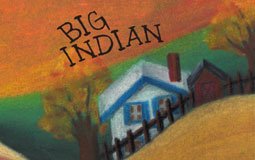| Return to Home The Origin of Oliverea and Big Indian
Taken from The Valley – Legends and Facts of Big Indian and Oliverea
 It is interesting to hear how the sister villages of Big Indian and Oliverea arrived at their names. Many years ago a family named Oliverara lived in the valley. Mr. Oliveara had come to the territory after his marriage to an ancestor of our own Andy Haynes, and settled permanently here. He raised a family and was respected by all, and the area became referred to as ‘Oliveara’s,” soon to be transformed to what is now “Oliverea.” It is interesting to hear how the sister villages of Big Indian and Oliverea arrived at their names. Many years ago a family named Oliverara lived in the valley. Mr. Oliveara had come to the territory after his marriage to an ancestor of our own Andy Haynes, and settled permanently here. He raised a family and was respected by all, and the area became referred to as ‘Oliveara’s,” soon to be transformed to what is now “Oliverea.”The naming of Big Indian was a somewhat more dramatic happening, and here we have the tale for you: Win-ni-sook was an Indian of perhaps the Algonkian tribe that used to occupy both sides of the Hudson in New York State. He was a little over 7 feet in height, well built and strong, and was very well known for his fearlessness, hence was called ‘The Big Indian.” Around the early 1700’s, Win-ni-sook joined forces with Ubewachah and fought a battle with them, in hopes of winning the hand of the Chief’s daughter, the beautiful Princess Utsayantha. Being rejected by both the chief and his daughter, he returned home to the valley and eventually eloped with a ‘paleface’ woman named Gertrude Molyneaux. Win-ni-sook and his band of braves conducted unsavory attacks and plundering of the local Dutch settlers. Returning from one of these raids Win-ni-sook was attacked with a bullet near his heart and took refuge in a hollow pine tree. His body was found the next day.
Around the year 1850, the decline and fall of the hemlock trees was seen. This was due to the fact that hemlock bark was used in the tanneries that dotted the area. The Wey tannery, which stood approximately where the Crnkovic pond is now, used perhaps 6,000 cords of hemlock bark per tree, the Smith tannery at Smithville used about 2,500. When a man was hired to work on the hemlock bark, he showed up in the spring of the year at one of the five or more huts that were built in the mountains. The huts were about 16 by 20 feet in size, with a ladder leading to a loft. The men slept in the few beds available, or on the floor, and suffered through the smoke from the fireplace or the mosquitoes. They stayed there from about May 10th until August, and the rest of the year the cabin was occupied by the family that owned it.
The men worked from ‘sun to sun,’ earning anywhere from $1.50 to $2.75 per day for stripping the giant hemlocks of their bark for a contractor, who sold it for $2.75 to $4.00 per cord, depending on whether it was peeled, piled up or delivered. The roads were kept busy by the teamsters, who hauled the finished product to Rondout, a trip taking three day’s time. On their return from Rondout, they would also be carrying a load of raw hides that had come from South America. Some of the tanneries purchased as many as 100,000 hides each year, and the process of tanning took several months.
This was the busiest this area has ever seen and hundreds of men were employed. The mountains were stripped of the beautiful hemlock trees, and the logs were left on the ground to rot, or to wait until someone needed firewood. Years later, these hemlock logs were cut into planks for the “Old Plank Road’ that was to be built from Pine Hill to Rondout, the magnificent sum of $5.00 per thousand feet being received for the planks for this purpose. The hemlocks are beginning to come back slowly, and can be spotted among the forest of maple, birch, beech, poplar, oak and pine that we have now.
In the late 1800’s when the railroad became a known fact and a trustworthy operation, the very first tourist came to this area, which opened up an entirely new concept of life. Farm houses began using their spare bedrooms and new homes were built to accommodate the influx of people coming to the country for a breath of fresh air and a taste of home-made butter. Boarding houses sprang up, some of which are still here today. As time went on, people arrived by auto, Delbert Griffin being one of the first to frighten the horses and raise dust by driving his Oldsmobile from Kingston to this area around 1911. Big Indian could be reached by rail, by boat to Kingston, then via buses.
|
